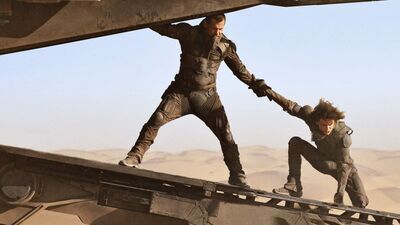“Dune” is at ease operating in this very particular epic narrative mode. It’s as good an example of this kind of storytelling as Robert Bolt’s “Lawrence of Arabia” script and Coppola’s interpretations of Mario Puzo, neither of which delved into the pysucholocal interiors of their main characters through any means besides showing them talking about the relative advisability of certain actions and then doing them. The screenplay (by Villeneuve, Jon Spaights and Eric Roth) has that “Godfather” knack for compressing and slimming a bestseller that readers loved partly because it was so thick with incident and legend, without making devotees feel that the source has been gutted, or twisted into inappropriate shapes. As of this writing, I’ve watched Part One five times, in whole or in pieces. With each revisit, I find myself more awed by the confidence with which it decides what to show us and for how long, and when to truncate a moment to get to the point, and when to let it play out because what’s happening on-screen is awesome and the viewer wants to be able to luxuriate in it.
The second half of this long-ish movie has unstoppable forward momentum, that rolling, rumbling energy that the great screenwriter William Goldman observed in commercial films like “Free Willy” or “Rocky” or “Titanic” when the story and characters fuse as the film heads into its grand finale and the entire contraption is “on rails.” “The Godfather’ is on rails from the moment when Michael fakes having a gun in his pocket to protect his dad from being killed through the final shot where he shuts the door in Kay’s face. “Die Hard” is on rails from the scene where Takagi is killed through the bloody embrace of John and Holly after Hans falls to his death. From the opening moments of the Harkonnen attack through the death of Duncan, the escape by ornithopter into a sandstorm, and Paul’s defining challenge in the canyon, “Dune” is on rails. It has that sort of inevitability, that level of craft.
The first time I saw it, I came away thinking it was a technically excellent adaptation of a behemoth of a book, with committed performances by an ensemble that all managed to be themselves but also the characters. (Ferguson, Chalamet, Isaac, Brolin, Momoa, Dave Bautista and many other cast members have movie-star energy here, by which I mean that they are doing the sorts of things that you expect them to do based on their other roles, yet it’s fun and engrossing to see them do them again, in a different register, like audiences in an earlier era seeing Humphrey Bogart in “The Maltese Falcon” as opposed to “The African Queen,” or Thelma Ritter in “All About Eve” as opposed to “Rear Window.”) But the next time I saw “Dune,” on a 15-meter-wide screen at a drive-in near Dallas, Texas, I appreciated it as a colossal digital spectacle, a series of widescreen moving paintings of Brutalist architecture, interstellar vistas, ant-hive troop formations, and shock-cut visualizations of betrayal, torture, prophecy, and madness. Since then, I’ve come to the conclusion that it’s a perfect cinematic object, a visual and aural and physical experience that worms its way into your mind and embeds it with timecode, so that the next time you watch it, you’re looking forward to your favorite moments, and can anticipate them without a watch, almost down to the second.
Tomorrow: 30 Minutes on Dune: Part Two.

